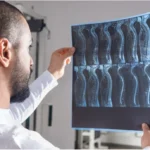Spinal cord injuries (SCIs) remain one of the most challenging medical conditions to treat, with profound and lasting effects on the lives of those affected. In the United States alone, there are approximately 17,000 new cases of SCI each year, with over 290,000 individuals currently living with some form of paralysis due to damage to the spinal cord. While there has been significant progress in managing the symptoms and improving the quality of life for SCI patients, the potential for fully restoring spinal cord function remains a distant goal. However, advances in regenerative medicine are ushering in a new era of hope, providing the possibility of groundbreaking treatments that could one day lead to significant recovery for those living with SCI.
Understanding Spinal Cord Injury
The spinal cord is the primary communication pathway between the brain and the rest of the body. It is responsible for transmitting motor, sensory, and autonomic signals. When the spinal cord is injured, whether through trauma or disease, these pathways are disrupted, leading to loss of movement, sensation, and in many cases, loss of autonomic functions such as respiration, bladder control, and heart rate regulation. The severity and location of the injury determine the extent of the impairment. While some individuals may experience partial recovery through physical therapy and rehabilitation, most spinal cord injuries result in permanent disability, as the spinal cord’s ability to regenerate naturally is very limited.
The Challenge of Regeneration
The human spinal cord has limited regenerative capacity due to several factors:
- Scar tissue formation: After an injury, the body forms scar tissue at the site of damage, which physically blocks the regrowth of nerve fibers.
- Lack of growth-promoting environment: The injured spinal cord does not provide the necessary biochemical and structural environment to support nerve regeneration.
- Myelin breakdown: The myelin sheath, which insulates nerve fibers, often deteriorates after SCI, hindering the transmission of signals between the brain and the body.
Overcoming these obstacles has been the primary challenge for researchers working to develop effective treatments for SCI.To know more about spinal cord injury, visit https://blankwhitescreen.online/spinal-cord-injury-attorney-a-guide/
Breakthroughs in Regenerative Medicine
While the challenges are substantial, recent advancements in regenerative medicine hold the potential to revolutionize SCI treatment. Several promising approaches are currently under investigation, each targeting different aspects of spinal cord injury repair:
1. Stem Cell Therapy
Stem cells have garnered significant attention for their potential to regenerate damaged tissues. In the context of spinal cord injury, stem cell therapy involves transplanting stem cells into the injured area to promote tissue repair, stimulate the growth of new nerve cells, and encourage the formation of new connections between neurons.
There are several types of stem cells being explored for SCI treatment, including:
- Embryonic stem cells (ESCs): These are pluripotent cells that can differentiate into any type of cell, including neurons. ESCs have the potential to generate new neurons, glial cells, and other necessary components for spinal cord regeneration.
- Induced pluripotent stem cells (iPSCs): These are adult cells that have been reprogrammed to a pluripotent state, offering a promising alternative to ESCs without the ethical concerns associated with using embryonic tissue.
- Neural stem cells (NSCs): NSCs are specialized stem cells that are capable of developing into the types of cells found in the nervous system, such as neurons and glial cells. NSC-based therapies have shown promise in animal models of SCI, with some evidence suggesting functional improvements.
In clinical trials, stem cell therapies have demonstrated varying degrees of success, including improvements in motor and sensory function, as well as enhanced tissue repair. However, challenges such as immune rejection, tumor formation, and optimal methods for delivering stem cells to the spinal cord remain critical areas of research.

2. Gene Therapy
Gene therapy is another innovative approach that seeks to enhance the body’s natural repair mechanisms. By delivering specific genes directly to the injured spinal cord, researchers aim to promote the growth and survival of neurons, support the regeneration of axons (nerve fibers), and modulate the inflammatory response that occurs after SCI.
One example is the delivery of growth factors such as brain-derived neurotrophic factor (BDNF), which plays a crucial role in promoting the growth of neurons and the repair of nerve connections. Similarly, the manipulation of genes responsible for axon growth and synapse formation could encourage more effective spinal cord regeneration.
While gene therapy offers great potential, it is still in the experimental stages and faces challenges related to the safe and efficient delivery of genetic material to the spinal cord.
3. Neuroprotective Agents
Neuroprotective agents are substances designed to protect nerve cells from damage following an SCI. These agents can reduce inflammation, decrease oxidative stress, and protect the remaining neurons from further harm. By minimizing secondary damage (the damage that occurs after the initial injury), neuroprotective drugs may help preserve spinal cord function and improve outcomes in patients with SCI.
Several experimental neuroprotective agents are currently being tested in clinical trials, including minocycline, riluzole, and lithium, all of which have shown promise in preclinical studies.
4. Bioengineering and Scaffold Implants
Bioengineering is another field that holds promise for improving SCI outcomes. Researchers are developing biodegradable scaffolds made from natural or synthetic materials to serve as a framework for nerve growth and tissue regeneration. These scaffolds can be implanted into the injured area, providing a physical structure that supports the regeneration of spinal cord tissue and guides the growth of nerve fibers.
In addition to scaffolds, biosynthetic tissues that mimic the structure and function of the spinal cord are being developed. These tissues could potentially replace damaged spinal cord segments and restore neural connectivity.
5. Electrical Stimulation and Neuroprosthetics
Electrical stimulation techniques are being explored as a way to enhance recovery following SCI. By applying electrical impulses to the spinal cord, researchers can stimulate nerve activity, encourage plasticity (the brain’s ability to reorganize and form new connections), and promote functional recovery. This approach is particularly promising for improving motor function and muscle control in patients with SCI.
In combination with neuroprosthetics, which are devices designed to restore lost function (e.g., robotic exoskeletons), electrical stimulation holds the potential to enhance mobility and independence for individuals with SCI.
The Road Ahead
While these advancements are promising, many of the regenerative therapies for SCI are still in the early stages of research and development. Clinical trials are essential to determine the safety, efficacy, and long-term outcomes of these treatments. Moreover, the complexity of spinal cord injuries, combined with the delicate nature of nerve regeneration, means that a single “cure” is unlikely to be found. Instead, a combination of therapies, such as stem cell transplantation, gene therapy, and rehabilitation, may be needed to achieve significant recovery.
Despite the challenges, the future of SCI treatment looks brighter than ever. With ongoing research, advancements in technology, and a deeper understanding of the biological mechanisms of spinal cord injury, we are closer than ever to the possibility of restoring spinal cord function and improving the lives of millions of individuals affected by this debilitating condition.
Conclusion
Regenerative medicine is transforming the landscape of spinal cord injury treatment. Stem cell therapy, gene therapy, bioengineering, neuroprotective agents, and electrical stimulation all offer exciting possibilities for improving the lives of people with SCI. While we are not yet at the point of achieving full spinal cord regeneration, the rapid pace of innovation in this field suggests that new treatments and therapies will continue to evolve, bringing us closer to a future where spinal cord injury is no longer a life sentence of paralysis.








